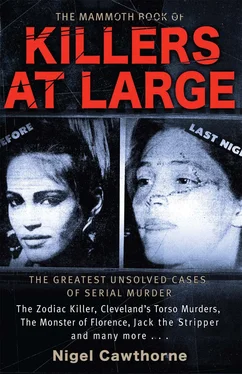The judge remarked that the chances of rehabilitation were “very poor if not non-existent”, noting that Mazingane had already been convicted of attacking his own wife.
In all, Mazingane was convicted of 74 charges, and was sentenced to life imprisonment on each of the 16 murder counts and life imprisonment for the most recent rape, which fell under the new legislation. He was sentenced to 18 years on each of the remaining 21 charges of rape. On the 20 counts of aggravated robbery he had been convicted of, he was sentenced to 25 years for the most recent one, and 15 years for each of the remaining 19. And he was sentenced to another 10 years on each of five counts of attempted murder. One victim had been shot three times but survived.
He received eight years for each of three counts of kidnapping, plus two years for assault, three years on each of the two charges of illegal possession of a firearm, and three years on each of the four charges of illegal possession of ammunition.
Twenty-eight-year-old Mazingane was already serving 35 years for a crime committed late in 1998—the kidnapping, rape and robbery of an attorney’s wife and an attack on a motorist who stopped to help. He was in jail for that offence when he came to the attention of Superintendent Piet Byleveldt, who was investigating the unsolved Nasrec killings. However, the charges eventually laid against Mazingane were only the tip of the iceberg. At the time Police Director Henriette Bester detailed the extent of the Nasrec offences: “There are 53 cases, of which 51 of the victims were killed. Of the 51 murder victims, 32 were female, all of whom were raped. Seventeen of the victims were children between the ages of five and eight, of whom 11 were girls.”
Mazingane was convicted of only 16 of the slayings. He may have committed more that he was not charged with, but the chances are that there is at least one other killer—maybe more—still at large.
Then there is the mysterious case of David Selepe and the murder of more black women in Cleveland, an industrial suburb of Johannesburg. On 3 September 1994, just four months after South Africa’s first multi-racial election, a woman’s body was found on in the bushes near the Jupiter train station next to the township of Heriotdale. Four days later, a second body was found next to the M2 freeway, on the other side of Heriotdale. Later that same day, the third body was found near a mine dump nearby. All three were partially naked and had been raped and strangled. There was nothing on the bodies or around them to aid in their identification. However, their clothes indicated that, before the attacks they had been neatly dressed. They were certainly not prostitutes—the usual prey of serial killers.
Once stories of a serial killer began to circulate in the press, the Brixton Murder and Robbery Unit discovered that they had two similar cases, whose bodies had been found in the same area on 16 and 31 July. The first—that of a schoolgirl—had a curious message written on it. The murder had written in black ink on the inside of her left thigh: “We must stay here for as long as you don’t understand.” On her right thigh, he wrote: “She a beach and I am not fighting with you please.”
Brixton Murder and Robbery Unit took over the investigation from the local Heriotdale force. So when, on 19 September, a sixth woman’s body was found near a mine dump in Heriotdale, they went to investigate. Again the victim had been strangled. Her dress had been pushed up over her hips and her jumper had been pulled over her head.
What puzzled detectives was that none of the women they had found matched missing person reports. Although they were apparently respectable women, none of them had been reported missing. So identikits of the women were prepared to release to the press and television.
All six bodies had been found within a radius of just over three miles so, on 21 September, the police began to search Heriotdale and the surrounding area of Cleveland in earnest. They employed a police helicopter, two dogs and some 140 officers. They found the remains of two more bodies in an advanced state of decomposition. Their clothing had been pushed up under their armpits and they appeared to have been strangled with either their own belt or undergarments.
The police now had a total of eight dead women on their hands. All of them were aged between 18 and 30, black and well-dressed. Medical examiners established that at least two of them had been raped. And, disturbingly, there may be many more victims. The area was littered with numerous pieces of female underwear.
Also on the 21st, the body of the women found two months before was identified by her husband. Her name was Hermina Papenfus. Aged 25, she was a nurse at the Sandringham Clinic.
The search of the Cleveland area continued and, on 23 September, the police found a rock splattered with blood, a pair of women’s sandals and a bloodstained shirt in the bushes some 50 feet from a footpath that ran between the factories. The police believed that these belonged to the fifth or sixth victim. A search of the wider area discovered no more corpses.
On 26 September, the body of the woman found on 3 September near the Jupiter station was identified by her father. She was 23-year-old Ntombi Maria Makhasi, a resident of Orlando West in Soweto. A student of fashion design at the Elna Design School in Johannesburg, her teachers described her as friendly and responsible. She disappeared on 2 September after telling a classmate that she would not be at school that day because she was going to the province of KwaZulu-Natal a couple of hundred miles to the southeast to visit her mother who was ill. Her father told the detectives that she used buses and South Africa’s numerous taxis and minibuses for transport. Hermina Papenfus also used the taxis.
Dr Micki Pistorius, South Africa’s first psychological profiler, joined the investigation on 28 September. The similarities between the cases were manifest, she said. All the victims were black, young, attractive—women who took a pride in their appearance and were not destitute. The killer’s modus operandi was consistent. He had taken the women to an industrial area, raped them and strangled them with a piece of their own clothing—usually a belt, bra or pantyhose. Then he left the body totally or partially naked.
Pistorius concluded that the killer was a black man in his late twenties or early thirties. Based on the women’s appearance, he was charming, well-dressed and well off with an expensive car—it was unlikely that women like these would go with someone who did not have a winning personality and portray himself as a man of means. Investigators thought that he might have derived some of his income from fraud or theft. He was certainly self-employed—at that time, few black men with a regular job would have the means or the free time to go around picking up women. Pistorius also surmised that he was married.
The message left on the body of the first victim indicated that he had a profound hatred of women. He called his first victim, a schoolgirl, a “beach”—presumably meaning “bitch”. The written message also suggested that he had difficulty expressing his feelings. He could not tell the woman what he felt when she was alive, so he wrote it on her body when she was dead.
Pistorius told the Beeld that the killer “feels dead inside. He probably thinks about death all the time. He fantasizes about every murder and tries to commit the perfect murder, because he has a drive to kill, but he doesn’t understand it. To kill is the only way he can release his feelings and his identity.” Asked whether he would stop killing, she said: “He can’t.”
Another thing Pistorius noted was that Ntombi Makhasi’s body was found on 3 September in the exactly same place as Hermina Papenfus’ body had been found on 31 July. Then on 19 September, a third body was found there. Pistorius suggested that the police keep the area under surveillance. But the killer was one step ahead. His profile concluded that he was an arrogant and intelligent man who read the newspapers. He knew what was going on and switched his dumping ground.
Читать дальше











